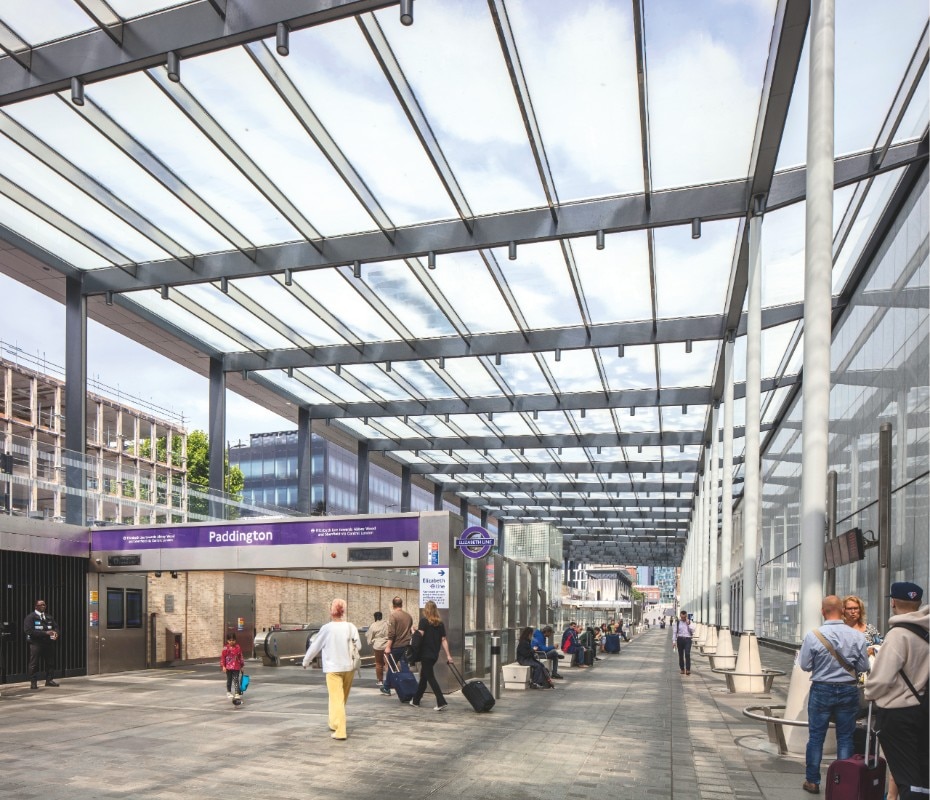Paddington is the oldest mainline station on the Elizabeth Line, familiar to millions of people arriving from Heathrow into London. Designed by Isambard Kingdom Brunel, Paddington is Grade I listed and an icon of Victorian railway engineering – setting the bar high for its Elizabeth Line addition. WW+P Architects’ Elizabeth Line station at Paddington is the culmination of over ten years’ work by the practice at the station, transforming the passenger experience by radically improving routes to and through the station, and opening up new connections.
It occupies the site of the station’s former taxi rank, which was a gloomy, fume-filled canyon – difficult to access, and an unattractive and unfriendly start to travellers’ journeys in London. Today, Paddington has a highly visible and navigable main entrance for the first time, with the Elizabeth Line entrance extending alongside Eastbourne Terrace beneath a 2,300 sq.m glazed roof incorporating Cloud Atlas – new artwork etched into the canopy by artist Spencer Finch. From a 300 metre long new public plaza, lifts and escalators take passengers onto the Elizabeth Line station concourse and platforms below, or into the mainline station through a series of new entrance portals. At street level, a pair of ventilation shaft enclosures, help to frame the station entrance, and hint at the grandeur beneath.

As one of only two box stations (alongside Weston Williamson + Partners’ other Elizabeth Line station at Woolwich) the design and delivery of Paddington was a major achievement, requiring extensive deep excavations and complex engineering immediately adjacent to Brunel’s historic station in a busy part of central London. The result is as impressive as its construction and, descending to the concourse, the epic scale of the new Elizabeth Line station is revealed.
The station features a 90-metre clear opening – a unique feature for urban underground station design – harnessing space, scale and light to match the grandeur of Brunel’s original station, and creating a uplifting and carefully-detailed space intended to claim its own legacy. WW+P Architects harnessed the box station construction technique to bring daylight and natural ventilation deep into the station: uniquely on the Elizabeth Line’s new central section it is possible to stand on the station platforms and look directly up to street level. Its robust engineering is celebrated – for instance in eight gigantic flared elliptical columns, cast in bronze to head height, which carry the weightof the structure above. There are careful details too – such as the tall hit-and-miss flank wall (which also has an acoustic function) and dark, the elegant stone paving to the entrance plaza, and beautiful anodised “ lily pad” light fittings set within saucer-like concrete ceiling coffers above the grand ticket hall.

The station is constructed on the same rigorous 10 foot imperial grid as Brunel’s station, and references to this – for instance in the floor tiling and colonnades – are there to be found. All services are cleverly tucked away out of sight towards the top of the station box, and ample provision has been made for future adaptations. Unlike other stations along the central section which feature a common design language, at Paddington (and also Woolwich) WW+P Architects was tasked with all station design from street to platform level. They used their expertise as infrastructure specialists to create a high quality, calm and legible station, designed to last for generations. The passenger experience lies at the heart of WW+P Architects’ approach to all design decisions at Paddington. Despite its size the station is nevertheless welcoming and easily navigable – qualities that the practice had applied earlier when addressing the shortcomings of the adjacent mainline station. As a result, Paddington’s 19th and 21st century elements are brought seamlessly together for the benefit of station users, and properly establishing Paddington as a key gateway to London.
Opening image: Courtesy Morley Von Sternberg


